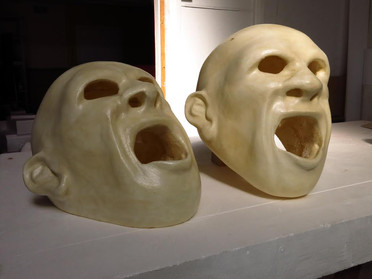What type of hard coating materials are recommended to be used over foam?
- Sigal Barnea
- Mar 19, 2021
- 3 min read
uncoated foam is sometimes too fragile for many uses. coating products are formulated to protect against impact and abrasion. It will protect it from wind, rain, snow, moisture, humidity and sunlight that might otherwise degrade the surface, and is meant to provide a protective shell to allow the product to last longer.
There are many different hard coating products out there. For our applications, we like to use Epoxy coating, Polyurea coating, Rubber-Latex coating and Polyurethane coating (both soft and hard).
So what is the difference between each one? What are the pros and cons of each and how do we decide when to use either one?

We use Epoxy hard coating for any foam product we fabricate where the customer requires a thin protective shell / if the product needs to be placed outside for a limited length of time (up to 2 month for ex) / for foam products that need to be placed in water such as pool letters. The epoxy, easily available, provides a shiny glossy look and a relatively smooth finish look. It does protect for a limited time but might not last a life-time since it’s thin. Some require sanding and patching after coating and prior to painting for a smoother texture finish.
The epoxy is applied by brushing or rolling it on the foam. Usually 1-2 coats will do the trick, sometimes a 3rd coat is required for extra protection. We let it dry completely for up to 24 hours (it cures at room temperature, best at around 75F degrees, but will cure between 60F-90F as well) , then we sand or prime or paint with acrylic paint.
It is a two part system with a resin to hardener mix ratio.
The epoxy is great for protecting signs, logos, letters, props, architectural facades and precast molds. The drawback of using epoxy is that upon impact it may crack or break, but it is an economical solution.
For a thicker, stronger coating, we turn to the Polyurea material (also known as Bed Liner). This is true if the project will be placed outdoors for a long period of time, if people will touch it, or if it needs to last a life-time. It is sometimes used as a replacement for fiberglass coating, as it is durable, strong. And water tight.
The Polyurea is more expensive than the epoxy and is a much more complex application process. It is usually sprayed on using a plural component sprayer system. For this process, you must have good experience and training applying the material to be done correctly and it needs to be sanded prior to priming and painting. After application, the sprayer needs to be cleaned very well or else particles might clog it and it would not work, not letting the coating material flow out for next use.
The Polyurea material cures rapidly in a matter of seconds and is hard to the touch yet stays flexible throughout its life. There are many flavors of Polyurea - Ranging from very hard like plastic and brittle to rubber-like. It is a great solution for spraying large surfaces (we even spray airplane hangers with it and other floorings), it’s waterproof and also comes in a fire retardant option.
The downside is that the material and process are expensive, as well as it requires constant machine maintenance.
Polyurea can be sprayed on any material ranging from foam, plastics, cardboard, wood, cement, and metals.
There are subcategories of the polyurea, such as StyroSpray1000. It achieves a thinner coat that is sprayed, brushed or rolled on. It is a cheaper process, yet it might be more dripping and requires more sanding and works best at humid environments.

Another protective shell we use is Polyurethane coating. It is good for industrial, art-related and hobbyist projects, and is available as rigid or semi-rigid resins. One type of urethane coating we like to use is the Rubber-Latex coating.
In cases where we want to provide a flexible, yet tough, strong and impact resistant coating, we use a rubber-latex coating finish by brushing it onto the surface. It is actually a flexible type of coating (creates a feeling of almost a squashy bounce ball). It bonds nicely onto different types of materials, such as EPS foam, fabric, metals, plastics and wood. This coating provides surface protection, flexibility and resistance to UV, abrasion and chemicals. It sets almost immediately, but cures in a matter of hours (sometimes taking up to 24 hours to completely cure) and cannot be sanded.

There are many other types of coatings out there, such as gel coat, fiberglass, plasters, cement and more. The type of hard coating we choose to use depends on the material and texture to be coated, the shape itself (if it has grooves and indentations that the coating materials needs to flow into), the finish needed (smooth vs semi-smooth) and the customer’s budget and turn around requirements for the project.














































ความคิดเห็น